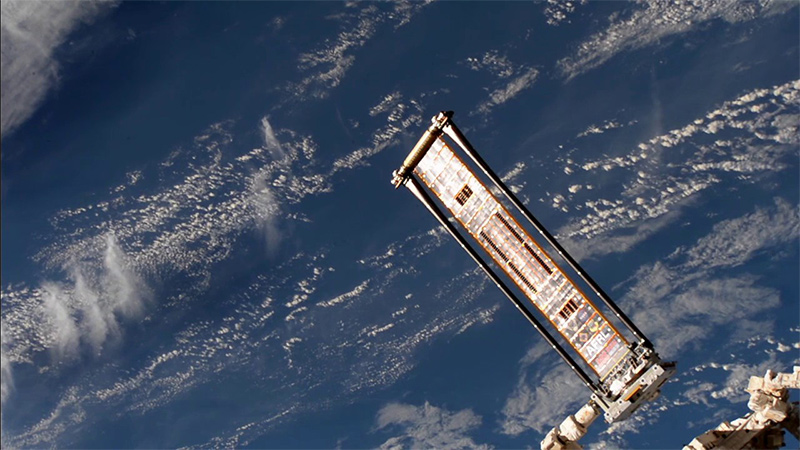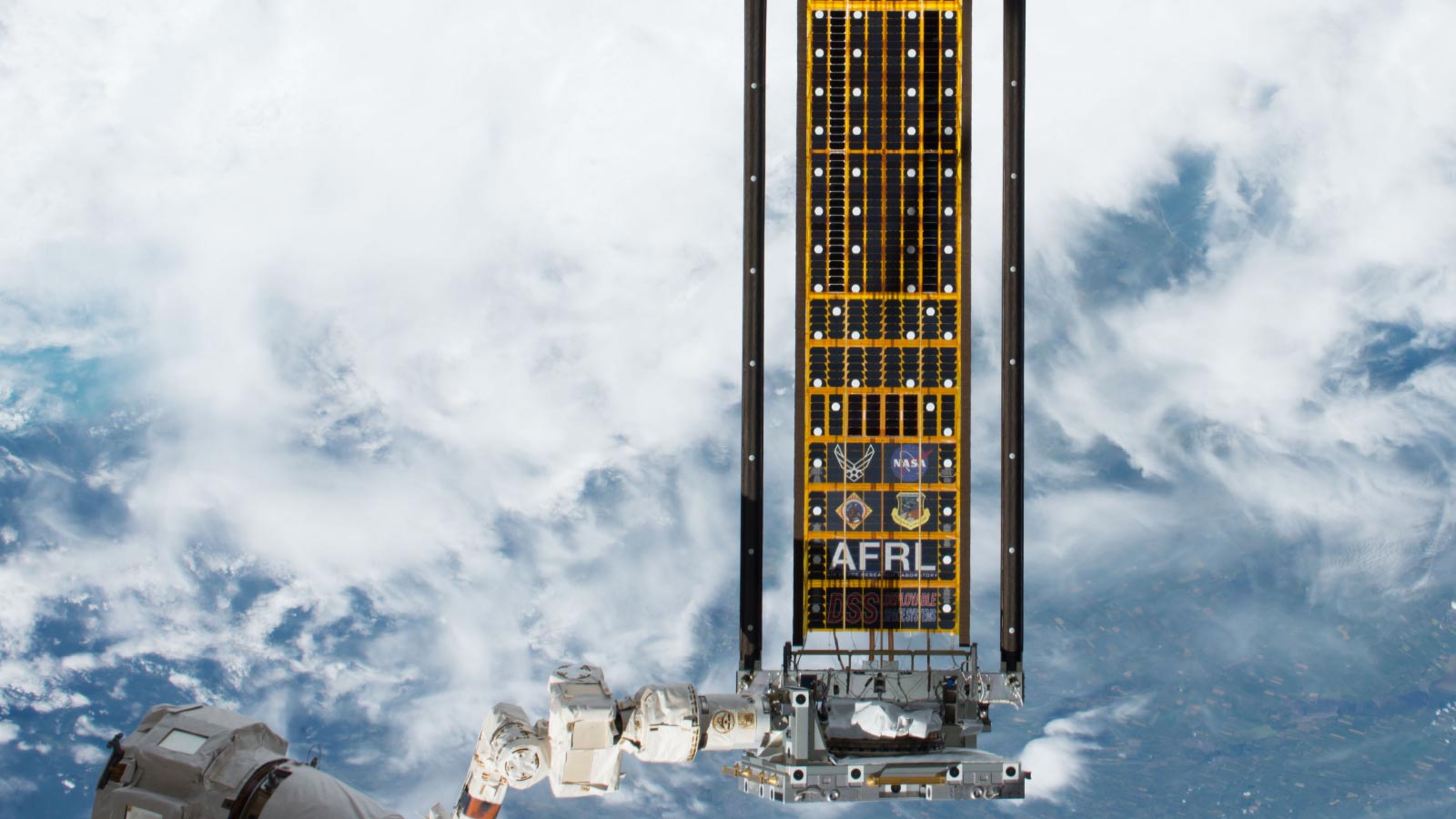Stay Up to Date
Submit your email address to receive the latest industry and Aerospace America news.
Space station experiment may reveal future for satellite solar arrays
Mechanical engineer Matt LaPointe, technical director at the small California company Deployable Space Systems, typed a command into a computer at NASA Mission Control in Houston as dozens of engineers looked on, their eyes riveted on a live stream from the International Space Station. After a few seconds, a latch on the end of the station’s Canadarm2 lifted, and a roll of photovoltaic cells mounted on a proprietary composite fabric began to unfurl like a noisemaker at a birthday party. Within two minutes, the 1.6-meter-wide strip was fully extended 6 meters, the sun sparkling off a surface covered with solar cells.
Meet ROSA, the Roll Out Solar Array. If the ROSA technology reaches space in operational form in two or three years as planned, it could completely disrupt the spacecraft market in a good way by delivering more power with dramatically less mass than today’s rigid, fold-out arrays.
“I’d seen [ROSA] deploy dozens of times on the ground but to see it work in space, in full sunlight with the Earth in the background, that was just epic,” says Harry Yates, a solar engineer at satellite-builder Space Systems Loral in California. SSL is a collaborator on ROSA with Deployable Space Systems and the Air Force Research Laboratory’s New Mexico directorate, which provided expertise and the majority of funds for development of ROSA and carrying out the space station experiment.
The June tests conducted over six days showed that ROSA’s flexible material and deployment mechanism survived their launch on a SpaceX Falcon 9 and worked as planned in microgravity. Once the latch released, the material unrolled automatically due to the pent up or “strain energy” of two compressed composite tubes, one on each side of the array. ROSA was mounted on a platform, which was also held in place by the Canadarm2, that housed the electronic controls for the experiment. This space version of a laboratory vibration table was equipped with sensors to gauge the deployed wing’s strength, stiffness and durability. The readings were transmitted to engineers on the ground for each of the four times the wing was released and retracted. Engineers from the Air Force and Deployable Space Systems gauged the deployed wing’s strength, stiffness and durability. They also measured the photovoltaic performance of ROSA’s solar cells at various temperatures, sun angles and when the array was in the space station’s shadow.
Other tests lie ahead, but the station experiment amounted to validating ROSA in the space environment, says Brian Spence, Deployable Space Systems founder and president.
For its part, SSL is offering customers the option of purchasing ROSA with its 1300 satellite bus, a design that has formed the foundation of 100 geosynchronous communications satellites since its introduction in 1989. The version of ROSA tested in June was not large enough for the 1300, so SSL plans to build a full-scale qualification model of a ROSA array and put it through testing. SSL needs to see how well the flexible material and cells respond to repeated thermal cycles. That testing will be completed over the first few months of 2018, Yates says.
For satellite designers, ROSA touches two of the letters in the SWAP (size, weight and power) tradeoff formula. Its canister and rolled-up array take up less volume and weigh less than today’s foldup arrays with their battery-driven motors and cranking mechanisms. At the same time, they generate more power.
“Mass is such a valuable commodity on a satellite that if we can shave just 10 or 20 percent off a large component like a solar array, we can put that mass toward more transponders on a communications satellite or toward a payload that is actually doing the mission,” says Jeremy Banik, ROSA principal investigator at the Air Force Research Laboratory’s Space Vehicles Directorate in Albuquerque, New Mexico.
The Air Force estimates that ROSA’s technology could help it reduce the mass of its next generation of communications and precision navigation and timing satellites for a savings of $1.4 billion.
NASA engineers think ROSA could be especially valuable as the source of power for solar electric propulsion, in which a propellant is electrified and accelerated to create thrust. Today, communications satellites often rely on solar electric propulsion for station-keeping. NASA is looking for far more powerful solar electric propulsion systems that could propel spacecraft from one orbit to another.
A candidate for the first demonstration of that technology could be the Deep Space Gateway, the crew habitat the agency wants to establish in lunar orbit in the early 2020s to begin preparing astronauts for future missions to asteroids or someday Mars. ROSA and a rival technology, Orbital ATK’s MegaFlex solar array, have “the operational and performance characteristics” for that mission, says Dave Manzella, the chief engineer for NASA’s Solar Electric Propulsion Technology Demonstration Project at NASA’s Glenn Research Center in Ohio.
For all those applications, the arrays would have to be significantly larger than the 1.6-meter-by-6-meter version that unfurled in orbit on June 18. The Air Force Research Laboratory gathered data on the structural dynamics of the deployed wing to improve the computer models that will predict the performance of larger arrays.
The Air Force Research Laboratory started funding the project in 2008 and NASA signed on in 2009 to pay for development of larger versions of ROSA.
In addition to funding, the Air Force Research Laboratory contributed a key component of ROSA when it transferred technology to Deployable Space Systems for carbon fiber laminate tubes, the components whose strain energy unfurls ROSA. Traditional rigid solar panels fold for launch and unfold in orbit along mechanical hinges. For simplicity’s sake, the Air Force Research Laboratory and Deployable Space Systems were eager to do away with the hinges.
“It’s a very elegant design,” Yates says. “The tubes rolled up flat for stowage want to return to a round cross-section. It’s that spring force that drives it to unroll.”
ROSA combines those tubes with photovoltaic cells and circuitry housed in common mass-produced modules that Deployable Space Systems combines to produce arrays of various sizes and shapes. “It scales up in size so much easier than a rigid panel array,” Banik says.
All those benefits are designed to lower the cost of producing power in orbit. “You get more power than you would with comparable rigid arrays in the same stowed volume,” Spence says. Plus, the flexible arrays generally weigh less than comparable rigid ones.
“Those metrics are important,” Banik says. “We can save money and increase capability.”
“It’s a very elegant design. The tubes, rolled up flat for stowage, want to return to a round cross-section. It’s that spring force that drives it to unroll.”
Harry Yates, a solar engineer at satellite-builder Space Systems Loral
About Debra Werner
A longtime contributor to Aerospace America, Debra is also a correspondent for Space News on the West Coast of the United States.
Related Posts
Stay Up to Date
Submit your email address to receive the latest industry and Aerospace America news.







